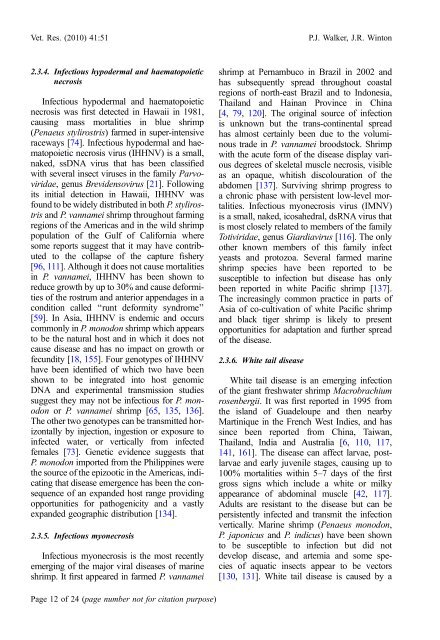Emerging viral diseases of fish and shrimp - Watershed Watch ...
Emerging viral diseases of fish and shrimp - Watershed Watch ...
Emerging viral diseases of fish and shrimp - Watershed Watch ...
Create successful ePaper yourself
Turn your PDF publications into a flip-book with our unique Google optimized e-Paper software.
Vet. Res. (2010) 41:51<br />
P.J. Walker, J.R. Winton<br />
2.3.4. Infectious hypodermal <strong>and</strong> haematopoietic<br />
necrosis<br />
Infectious hypodermal <strong>and</strong> haematopoietic<br />
necrosis was first detected in Hawaii in 1981,<br />
causing mass mortalities in blue <strong>shrimp</strong><br />
(Penaeus stylirostris) farmed in super-intensive<br />
raceways [74]. Infectious hypodermal <strong>and</strong> haematopoietic<br />
necrosis virus (IHHNV) is a small,<br />
naked, ssDNA virus that has been classified<br />
with several insect viruses in the family Parvoviridae,<br />
genus Brevidensovirus [21]. Following<br />
its initial detection in Hawaii, IHHNV was<br />
found to be widely distributed in both P. stylirostris<br />
<strong>and</strong> P. vannamei <strong>shrimp</strong> throughout farming<br />
regions <strong>of</strong> the Americas <strong>and</strong> in the wild <strong>shrimp</strong><br />
population <strong>of</strong> the Gulf <strong>of</strong> California where<br />
some reports suggest that it may have contributed<br />
to the collapse <strong>of</strong> the capture <strong>fish</strong>ery<br />
[96, 111]. Although it does not cause mortalities<br />
in P. vannamei, IHHNV has been shown to<br />
reduce growth by up to 30% <strong>and</strong> cause deformities<br />
<strong>of</strong> the rostrum <strong>and</strong> anterior appendages in a<br />
condition called ‘‘runt deformity syndrome’’<br />
[59]. In Asia, IHHNV is endemic <strong>and</strong> occurs<br />
commonly in P. monodon <strong>shrimp</strong> which appears<br />
to be the natural host <strong>and</strong> in which it does not<br />
cause disease <strong>and</strong> has no impact on growth or<br />
fecundity [18, 155]. Four genotypes <strong>of</strong> IHHNV<br />
have been identified <strong>of</strong> which two have been<br />
shown to be integrated into host genomic<br />
DNA <strong>and</strong> experimental transmission studies<br />
suggest they may not be infectious for P. monodon<br />
or P. vannamei <strong>shrimp</strong> [65, 135, 136].<br />
The other two genotypes can be transmitted horizontally<br />
by injection, ingestion or exposure to<br />
infected water, or vertically from infected<br />
females [73]. Genetic evidence suggests that<br />
P. monodon imported from the Philippines were<br />
the source <strong>of</strong> the epizootic in the Americas, indicating<br />
that disease emergence has been the consequence<br />
<strong>of</strong> an exp<strong>and</strong>ed host range providing<br />
opportunities for pathogenicity <strong>and</strong> a vastly<br />
exp<strong>and</strong>ed geographic distribution [134].<br />
2.3.5. Infectious myonecrosis<br />
Infectious myonecrosis is the most recently<br />
emerging <strong>of</strong> the major <strong>viral</strong> <strong>diseases</strong> <strong>of</strong> marine<br />
<strong>shrimp</strong>. It first appeared in farmed P. vannamei<br />
<strong>shrimp</strong> at Pernambuco in Brazil in 2002 <strong>and</strong><br />
has subsequently spread throughout coastal<br />
regions <strong>of</strong> north-east Brazil <strong>and</strong> to Indonesia,<br />
Thail<strong>and</strong> <strong>and</strong> Hainan Province in China<br />
[4, 79, 120]. The original source <strong>of</strong> infection<br />
is unknown but the trans-continental spread<br />
has almost certainly been due to the voluminous<br />
trade in P. vannamei broodstock. Shrimp<br />
with the acute form <strong>of</strong> the disease display various<br />
degrees <strong>of</strong> skeletal muscle necrosis, visible<br />
as an opaque, whitish discolouration <strong>of</strong> the<br />
abdomen [137]. Surviving <strong>shrimp</strong> progress to<br />
a chronic phase with persistent low-level mortalities.<br />
Infectious myonecrosis virus (IMNV)<br />
is a small, naked, icosahedral, dsRNA virus that<br />
is most closely related to members <strong>of</strong> the family<br />
Totiviridae, genusGiardiavirus [116]. The only<br />
other known members <strong>of</strong> this family infect<br />
yeasts <strong>and</strong> protozoa. Several farmed marine<br />
<strong>shrimp</strong> species have been reported to be<br />
susceptible to infection but disease has only<br />
been reported in white Pacific <strong>shrimp</strong> [137].<br />
The increasingly common practice in parts <strong>of</strong><br />
Asia <strong>of</strong> co-cultivation <strong>of</strong> white Pacific <strong>shrimp</strong><br />
<strong>and</strong> black tiger <strong>shrimp</strong> is likely to present<br />
opportunities for adaptation <strong>and</strong> further spread<br />
<strong>of</strong> the disease.<br />
2.3.6. White tail disease<br />
White tail disease is an emerging infection<br />
<strong>of</strong> the giant freshwater <strong>shrimp</strong> Macrobrachium<br />
rosenbergii. It was first reported in 1995 from<br />
the isl<strong>and</strong> <strong>of</strong> Guadeloupe <strong>and</strong> then nearby<br />
Martinique in the French West Indies, <strong>and</strong> has<br />
since been reported from China, Taiwan,<br />
Thail<strong>and</strong>, India <strong>and</strong> Australia [6, 110, 117,<br />
141, 161]. The disease can affect larvae, postlarvae<br />
<strong>and</strong> early juvenile stages, causing up to<br />
100% mortalities within 5–7 days <strong>of</strong> the first<br />
gross signs which include a white or milky<br />
appearance <strong>of</strong> abdominal muscle [42, 117].<br />
Adults are resistant to the disease but can be<br />
persistently infected <strong>and</strong> transmit the infection<br />
vertically. Marine <strong>shrimp</strong> (Penaeus monodon,<br />
P. japonicus <strong>and</strong> P. indicus) havebeenshown<br />
to be susceptible to infection but did not<br />
develop disease, <strong>and</strong> artemia <strong>and</strong> some species<br />
<strong>of</strong> aquatic insects appear to be vectors<br />
[130, 131]. White tail disease is caused by a<br />
Page 12 <strong>of</strong> 24 (page number not for citation purpose)
















